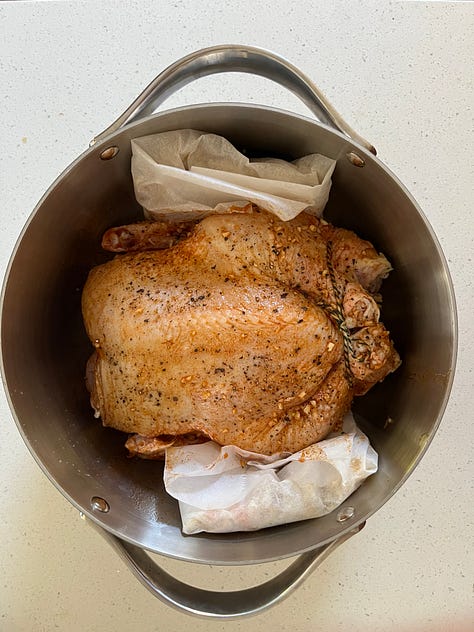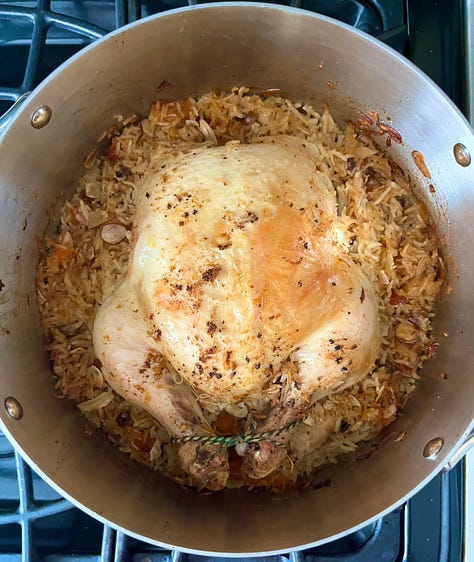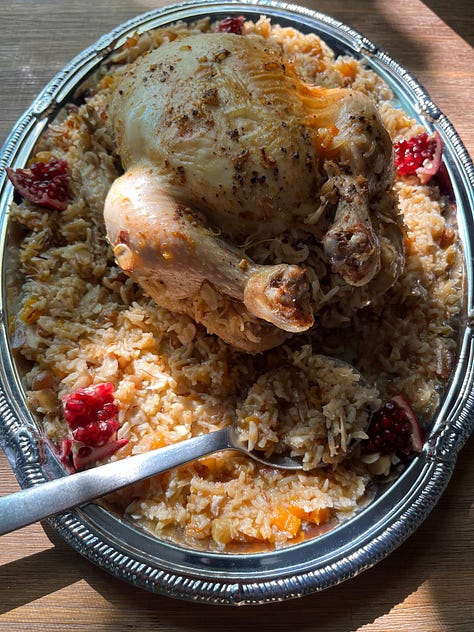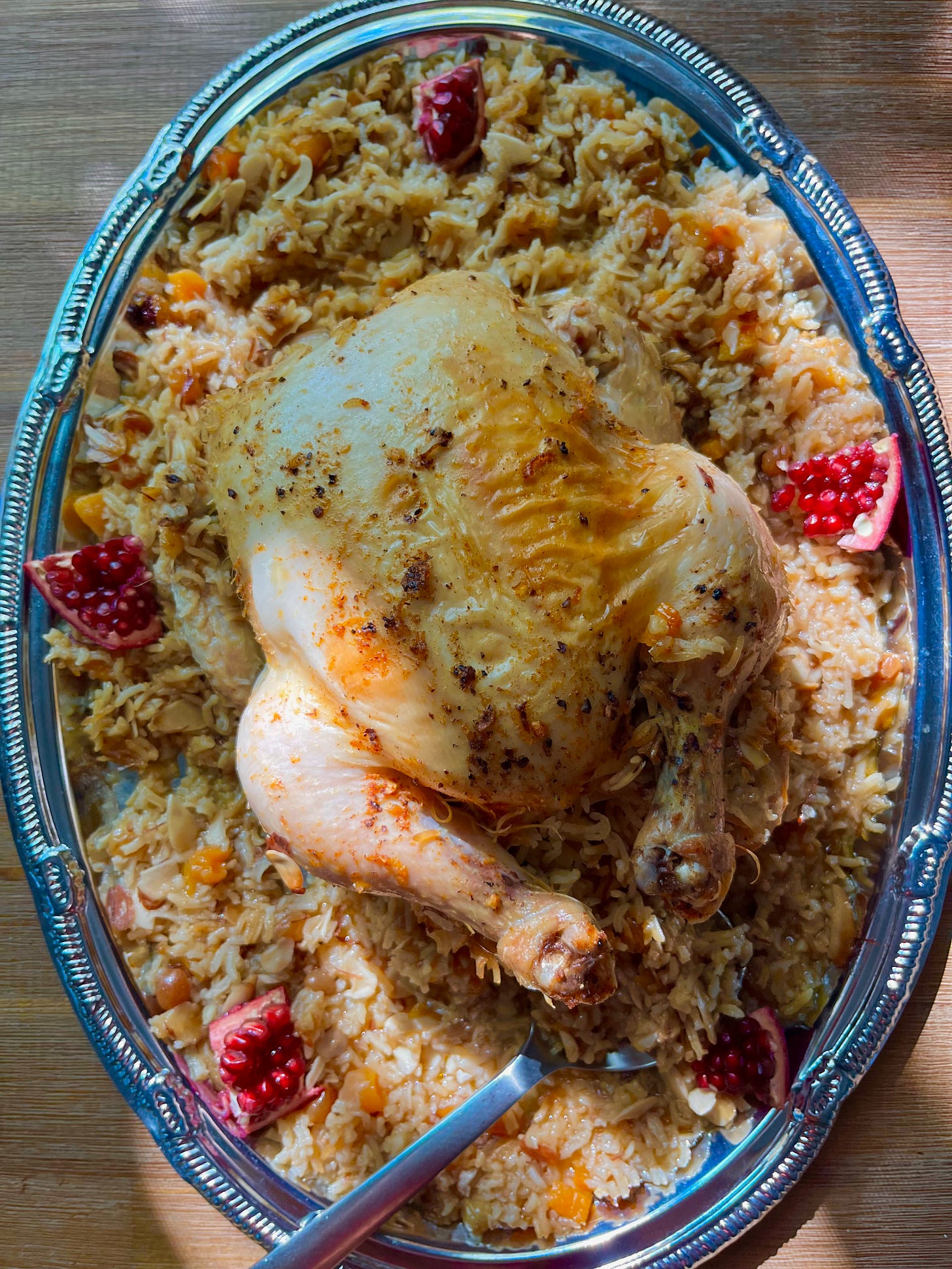Rice and Caramelized Onion-Stuffed Chicken
A Syrian Jewish-inspired showstopper for Rosh Hashanah
Rosh Hashanah Discount! So many of you took advantage of the recent back to school subscription discount—hello new subscribers! If you missed the deadline, I totally get it. (Life, amirite?) But you have another chance: From now through October 2, new paid subscriptions to The Jewish Table are 20% off. This will be the last discount opportunity for a while, so don’t miss out on the weekly stories and recipes from around the Jewish world. Upgrade to paid here or below.
Hello The Jewish Table Readers,
High Holiday prep is in full swing around here. If you missed last week’s Early Autumn Fruit Platter with Chocolate Tahini Dip (aka the easiest, most beautiful Rosh Hashanah dessert possible), you can find that here.
This week, we’re talking main dishes—particularly this gorgeous Rice and Caramelized Onion-Stuffed Chicken recipe inspired by Syrian Jewish cuisine. I live in South Brooklyn, just a handful of blocks away from the borough’s bustling Syrian Jewish enclave. So while I am not Syrian myself, I feel a special affinity for my neighbors.
For guidance, I turned to Poopa Dweck’s beautiful cookbook Aroma’s of Aleppo: The Legendary Cuisine of Syrian Jews. Dweck’s book, along with Jennifer Abadi’s A Fistful of Lentil’s, provide a trove of historical and family recipes and stories for any interested home cook. I have made several dishes out of Aroma’s of Aleppo, and love how she brings a reverence for history and tradition to everything she makes.
Her stuffed chicken recipe, (called djaj mehshi in Arabic) is a particular stunner—a whole bird that gets filled with rice flavored with nuts, cinnamon, and allspice, and roasted until fragrant and tender.
I made a few significant tweaks to Dweck’s original recipe (even though it is delicious as is). Most notably, I omitted the ground beef or lamb she adds to her stuffing, because the dish felt hearty enough without additional meat. I replaced the meat with caramelized onions and dried fruit. Like Ashkenazi cuisine, Syrian Jewish cuisine includes several recipes that pair savory dishes with fruit (like kebab garaz— meatballs stewed with dried cherries), so the substitution feels apropos. Meanwhile, browned onions are never out of place!
Dweck’s recipe instructs that the bird should be roasted in a relatively low oven for two hours, which unlocks rotisserie-levels of tenderness. But a low-and-slow cooking approach doesn’t add much in the way of browning, so I added a quick blitz of higher heat right at the end to help get the skin golden and crisp. She also calls for short-grain rice, but I had better luck with basmati, which stays fluffy and avoids mushiness, even after the extended cooking time. The final dish is sumptuous, nourishing, and festive, with a hint of sweetness—everything you want for Rosh Hashanah dinner.
You can find my take on Dweck’s stuffed chicken below. But first for all my history buffs, here’s a bit of background on Syrian migration (both Jewish and not) to New York City.
Brooklyn’s Syrian Jewish Community
From the 1880s to the 1940s, Manhattan Lower West Side was home to “Little Syria” - a diversely populated neighborhood that included tens of thousands of immigrants from Ottoman Syria (a land mass that today includes parts of Syria, Lebanon, Jordan, Israel, and Palestine.) The NYC neighborhood flourished with culture and literature, and was home to poets and intellectuals like Kahlil Gibran. The streets were lined with Arab-American shops selling food, textiles, and home goods, and housed the printing press for Arabic-language newspapers.
This period almost exactly mirrors the immigration patterns taken by Eastern European Jewish immigrants, who settled those same decades not far away on New York’s Lower East Side. And just like New York’s Ashkenazi Jews, who left crowded Manhattan for greener pastures as soon as they were financially able to, by the 1940s, many of the original Syrian immigrants and their descendants began to move to Brooklyn, New Jersey, and further afield.
As a side note, anyone who has ever had the good fortune of shopping at Sahadi’s—the iconic Middle Eastern grocery and prepared foods store in Brooklyn Heights—has tasted the fruits of this migration pattern firsthand. (Sahadi’s was founded in 1895 in Manhattan’s “Little Syria,” and relocated to Brooklyn in 1948.)
Syrian Jews from Aleppo and Damascus began arriving New York in the early 1900s, a generation after the first Syrian immigration wave began. They initially joined Ashkenazi Jews on the Lower East Side, but soon relocated to Brooklyn’s Bensonhurst neighborhood. According to the Brooklyn Jewish Historic Initiative, “At first the convergence of the two groups was not easy. The Aleppan Jews, or Halabis, thought themselves superior, largely due to their history in Syria as a center of Jewish learning. The Damascene Jews, or Shammies, prayed in a different house of worship.”
Before long, however, the two groups began to mingle and intermarry. The community grew and, as many families moved up the financial ladder, expanded beyond Bensonhurst. Today, the majority of Brooklyn’s Syrian Jews live in and around Midwood—including in the magnificent mansions that line the southern stretch of Ocean Parkway—and also in Deal, an affluent neighborhood along the New Jersey shore. While part of New York’s larger Jewish community, Syrian Jews have remained a tightly-knit group with their own network of synagogues, schools, community centers, and food shops.
Next time you are in Brooklyn, make sure to visit Sahadi’s (mentioned above) and Mansoura’s—a kosher pastry and sweets shop founded by a Syrian-Egyptian Jewish family in 1961. Their flaky baklava and pistachio ma’amoul alone are worth the trip to South Brooklyn. Until then, let me know if you try this Rice and Caramelized Onion-Stuffed Chicken for Rosh Hashanah, or whenever the mood for autumnal comfort food strikes.



Rice and Caramelized Onion-Stuffed Chicken
Stick to basmati rice for this recipe—other varieties tend to get mushy during the extended cooking time.
Serves 6 to 8
Keep reading with a 7-day free trial
Subscribe to The Jewish Table to keep reading this post and get 7 days of free access to the full post archives.



